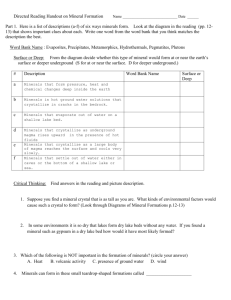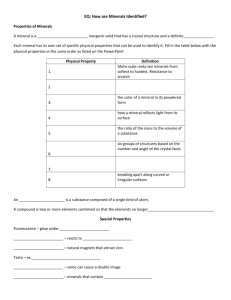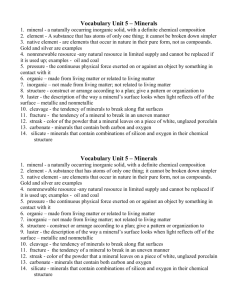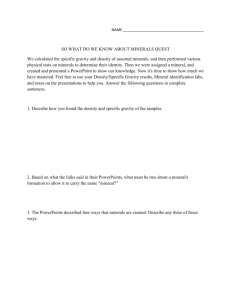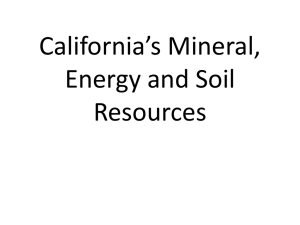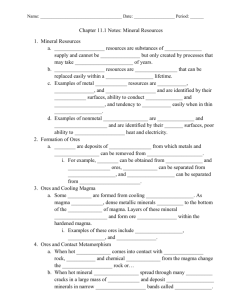Minerals
advertisement
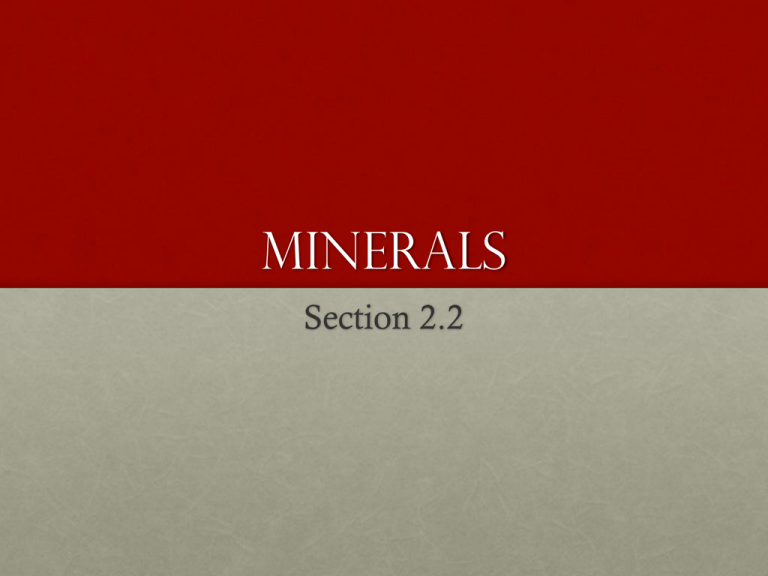
Minerals Section 2.2 Section 2.2 A mineral is a naturally occurring, inorganic solid with an orderly crystalline structure and a definite chemical composition. • In order for a material to be considered a mineral it must have the following characteristics: • • • • Naturally Occurring – not man made Solid Substance – solid in normal temp. Orderly crystalline structure – atoms arranged in an order Definite chemical composition – has a specific chemical formula • Generally considered inorganic – not living Section 2.2 • Which of the following items are minerals and which are not? Salt Coal Silver Steel Sugar Gold Glass Wood Concrete Snowflake Seashell Bone Section 2.2 • How minerals form: • Crystallization from magma – as magma cools, elements combine to form minerals ( Quartz, Feldspar, Muscovite) • Precipitation – as Earth’s water evaporate dissolved substances can react to form minerals (Halite & Calcite) • Pressure & Temperature – when minerals are exposed to pressure or temp their atomic structure can change to form new minerals (Talc & Muscovite) • Hydrothermal solutions – extremely hot solutions come into contact with minerals and cause chemical reactions that form new minerals (Bornite & Chalcopyrite) Crystallization of Magma Mineral Groups • Minerals are classified into groups based on their chemical composition • Silicates • Most common group of minerals • Contain Silicon (Si) and Oxygen (O) • The structure is a tetrahedron, which consists of one silicon atom and four oxygen atoms Mineral Groups • Carbonates • Second most common mineral • Contain Carbon (C), Oxygen (O) and one or more other metallic elements • Calcite (CaCO3) is the most common carbonate • Limestone & Marble contain carbonates • Oxides • Contain Oxygen (O) and one or more other elements, usually metals • Corundum (Al2O3) and Hematite (Fe2O3) are examples Mineral Groups • Sulfates & Sulfides • Contain Sulfur (S) • Can form from mineral rich waters or thermal solutions • Pyrite (FeS2) & Galena (PbS) are examples Mineral Groups • Halides • Contain a halogen ion plus one or more other elements • Includes the elements Fluorine (F) & Chlorine (Cl) • Halite (NaCl) is an example • Native Elements • Are elements in their pure form • Gold (Au), Silver (Ag) and Copper (Cu) are examples • Some form from hydrothermal solutions Mineral Groups • Copper



